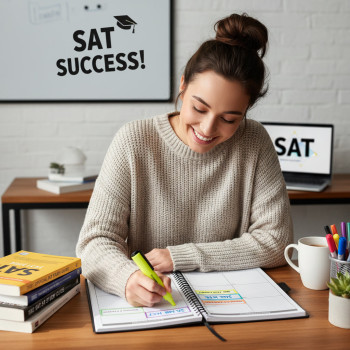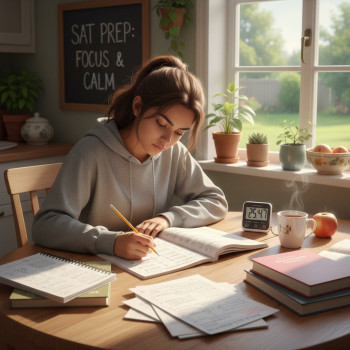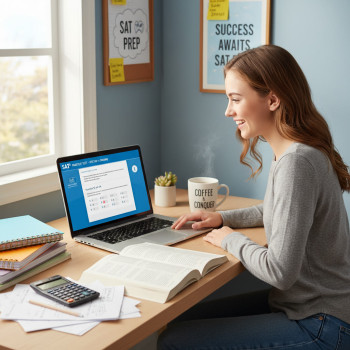Why screen time matters for Digital SAT prep
Studying for the Digital SAT is, fundamentally, a screen-bound activity. Official practice tests, Bluebook previews, Khan Academy lessons, timers, note apps, and question banks — they all live on a screen. That convenience is powerful: it helps you practice the exact format you’ll see on test day. But more time in front of a device doesn’t automatically mean better scores. How you use the screen, the rhythm of your sessions, and the boundaries you set determine whether your hours are productive or draining.
This post is a friendly, practical guide to optimizing your screen time so every digital study session moves you closer to your target score without wrecking sleep, focus, or mood. We’ll cover tactics you can start using today: scheduling, environment setup, effective digital tools, human-centered habits, and ways a personalized approach — like Sparkl’s 1-on-1 tutoring and tailored study plans — can amplify what you do on the screen.
Start with clarity: define your goals and your screen budget
Set a target score and break it down
Begin by naming a specific, realistic goal. Don’t say “get better.” Say “add 80 points to my SAT score” or “move from 600 to 680 in Math.” A clear target helps you identify which sections need more screen practice and which need offline review (like handwriting equations or doing scratch-work on paper).
Decide your weekly screen budget
Think of screen time as an investment with a budget. Instead of unlimited hours, pick a weekly target based on your timeline and energy level. For example:
- 8–10 weeks before the test: 8–12 hours/week of focused digital study.
- 4–7 weeks before: 10–15 hours/week, with at least two full-length practice tests in Bluebook.
- Last 2–3 weeks: 6–10 hours/week — mostly targeted practice and light review.
That budget is flexible — the key is to distribute it in focused blocks (not scattered doomscrolling). Keep at least one day with minimal screen work each week to recharge.
Create a screen-friendly study environment
Design a distraction-minimizing digital workspace
Your laptop or tablet should feel like a test room, not a social media portal. A few quick changes make a huge difference:
- Turn off nonessential notifications or use a “Do Not Disturb” schedule while studying.
- Use a dedicated browser profile or a different user account for study — no social media bookmarks, no tempting tabs.
- Keep the Bluebook practice app and your question bank easily accessible; close everything else.
- Use full-screen mode during practice tests to simulate the official environment.
Optimize display settings
Small visual tweaks reduce eye strain and help you stay engaged longer:
- Warm color temperature in the evening; default or cooler during the day.
- Increase text size slightly for reading passages to avoid squinting.
- Use high-contrast settings if it helps you parse charts and graphs.
Structure your sessions: quality beats quantity
Use the Pomodoro approach — but intelligently
Short, intense bursts work. Try 25–45 minute study blocks with 5–10 minute breaks. For longer review or practice tests, shift to 50 minutes on/10 minutes off. The aim is to keep your cognitive load high during screen time and give your eyes and brain regular micro-rests.
Mix active and passive screen activities
Not all screen time is equal. Active screen time drills your skills; passive screen time reinforces learning:
- Active: timed Bluebook practice sections, question bank drills, working through math problems step-by-step.
- Passive: watching short explainer videos, reading strategy guides, reviewing explanations after practice.
Rotate between the two to avoid fatigue: two active blocks then one passive block is a simple pattern that works well.
Schedule one full digital practice test per week as you get closer
Full-length Bluebook practice tests are the best use of your screen time because they simulate test-day pacing and tools. Early in prep, do a diagnostic to learn your baseline. In the final month, take at least one full practice test per week and simulate test day: same start time, same device, minimal snacks, and a 50–minute break schedule if that mirrors the real test.
Blend on-screen study with off-screen practices
Why you should still use paper
The Digital SAT still rewards handwriting for math scratch work and written note-taking helps memory. Use paper for:
- Working math problems while timing yourself on-screen.
- Taking notes on reading passages and mapping argument structure.
- Writing quick vocabulary cards or summary sheets.
Sample hybrid study schedule
Here’s a balanced day of study that respects screen limits:
| Time | Activity | Type |
|---|---|---|
| 4:30–5:15 PM | Bluebook practice — Reading section (timed) | Active screen |
| 5:15–5:25 PM | Break — walk/stretch, no screens | Off-screen rest |
| 5:25–6:00 PM | Paper review — annotate passage notes and summarize errors | Off-screen analysis |
| 6:00–6:30 PM | Video lesson on targeted grammar rule | Passive screen |
| 6:30–7:00 PM | Flashcards and mental math drills (paper/cards) | Off-screen practice |
Use tools that help you study smarter, not harder
Official and trustworthy digital tools
Focus your main practice on official resources and high-quality adaptive platforms. Reserve third-party apps for supplemental activities only. When you use official practice, you become familiar with Bluebook tools and test pacing. Use the student question bank for targeted work on weak skill areas and treat full-length Bluebook tests as checkpoints.
Digital aids to enhance productivity (but use them sparingly)
- Ad blockers and site blockers during study blocks to prevent pop-ups and social media detours.
- Text-to-speech for long reading passages when fatigue sets in — good for variety, not a constant crutch.
- Note apps (like simple markdown editors or digital notebooks) to collect wrong-answer patterns and reusable templates for problem solving.
Protect your body and mind while studying on screens
Eye and posture care
Digital study can be physically demanding if you ignore posture and eye health. Follow the 20-20-20 rule: every 20 minutes, look at something 20 feet away for 20 seconds. Sit with feet on the floor, screen at eye level, and use an external keyboard or a stand where possible. Simple changes reduce fatigue and help you sustain longer, higher-quality sessions.
Sleep, blue light, and evening study
Late-night screen sessions can disrupt sleep. If you study after sunset, use warm color settings and limit stimulating practice (like full test sections) right before bed. Reserve evenings for low-arousal review: vocabulary, light reading, or paper-based problem solving.
Make mistakes your roadmap — track and reflect
Keep an error log
An error log is one of the highest-return habits. After every practice section, record:
- Question type.
- Why you missed it (timing, careless error, concept gap, misread).
- How you’ll fix it (strategy change, content review, more practice).
Digital practice platforms give immediate feedback, but the power is in the reflection. Spend 20–30 minutes after a practice test categorizing errors and scheduling targeted drills for the following week.
Smart scheduling: prioritize deep work and recovery
The weekly flow that prevents burnout
A sample weekly flow balances intensity and recovery:
- Monday–Thursday: focused, skill-based screen sessions (50–70 minutes each with breaks).
- Friday: lighter review and passive learning (videos, strategy notes).
- Saturday: full-length digital practice test (simulate test day).
- Sunday: active recovery — off-screen review, physical activity, and error-log planning.
Adjust for school workload
When school gets intense, trim total hours but keep quality: shorter, more frequent bursts (3 x 30 minutes) beat one long, exhausted session. The point is consistency — 30 focused minutes a day beats six unfocused hours once a week.
Leverage human support: when to ask for help
How personalized tutoring fits naturally into screen-time planning
One of the smartest optimizations is to bring in a focused human: a tutor who understands your patterns and helps you use screen time efficiently. Personalized tutoring (like Sparkl’s 1-on-1 guidance) can do several things your solo screen sessions can’t:
- Diagnose whether an error is conceptual or strategic and tailor practice accordingly.
- Create a study plan that fits your screen budget, energy rhythms, and school schedule.
- Give targeted mini-lectures that replace unguided screen time with high-value instruction.
- Provide accountability and feedback so your digital practice becomes more productive.
Working with an expert tutor can mean you spend fewer hours on the screen but get better improvement because each minute is sharper, targeted, and corrected in real time.
How to get the most out of tutoring sessions
- Bring a copy of your error log and recent practice test to every session.
- Tell your tutor your screen limits and preferred session length so they craft a plan that’s sustainable.
- Ask for small takeaways you can practice independently in short screen bursts between sessions.
Practical strategies for avoiding common screen-time traps
Trap 1: Passive scrolling dressed up as “study”
Solution: start every session with a clear objective (e.g., “correct 10 algebra errors and review solutions”) and end with a 5-minute note of what you learned.
Trap 2: Overusing video explanations
Videos are helpful, but they can be passive. Use videos for concepts you can’t grasp in text or a worked example. Then, immediately apply the concept on 3–5 practice items.
Trap 3: Using too many apps
Limit yourself to 2–3 core resources: Bluebook (practice tests), a question bank for targeted practice, and one study planner. Extra apps dilute focus and make tracking progress harder.
Sample 8-week plan: balance screens, paper, and human help
This plan assumes you have a target test in 8 weeks and can commit 8–12 hours/week. Tweak for your timeline.
| Week | Focus | Screen activities (per week) | Off-screen activities |
|---|---|---|---|
| 1–2 | Baseline & foundations | 1 diagnostic Bluebook test, 3 skill sessions, 2 video lessons | Paper error log, math scratch practice |
| 3–4 | Target weaknesses | 2 practice sections, 1 full test on week 4, focused drills | Timed paper math drills, reading annotations |
| 5–6 | Strategy & pacing | 2 full Bluebook tests, pacing drills, question bank mastery | Error log synthesis, mock-proctor simulation |
| 7–8 | Polish & confidence | 1–2 full tests, light targeted drills, review of mistakes | Sleep-focused nights, light off-screen review |
Measuring progress without screen obsession
Key metrics to track
Focus on measures that reflect learning, not just time spent:
- Section score trends on full-length practice tests.
- Percentage of repeat errors in your error log.
- Time-per-question improvements in question-bank drills.
- Ability to explain a problem in your own words (verbal mastery).
Weekly check-ins with your tutor or with a study partner can convert these metrics into actionable next steps.
When to pivot: recognizing diminishing returns
More screen time eventually yields smaller gains. Watch for signs your study is becoming counterproductive:
- Same types of errors repeat despite more hours logged.
- Longer study blocks produce fewer correct answers.
- Sleep quality or mood suffers.
If that happens, switch to guided tutoring sessions, swap digital drills for paper review, or shorten your sessions and increase rest. Precision beats volume.
Final checklist: a one-page guide to healthier, smarter digital SAT study
- Define a clear target score and weekly screen budget.
- Use full-screen Bluebook practice to simulate test day.
- Mix active and passive screen work; pair digital practice with paper review.
- Use 25–50 minute focused blocks with breaks; follow the 20-20-20 eye rule.
- Keep an error log and review it weekly.
- Limit tools to essentials and block distracting sites during study.
- Schedule one full practice test per week in the final month.
- Bring in targeted, personalized help (for example, Sparkl’s 1-on-1 tutors and tailored study plans) when progress stalls.
- Prioritize sleep, posture, and recovery — they compound learning.
Parting thought: make your screen a tool, not a trap
The Digital SAT asks you to be digitally fluent and cognitively nimble. That combination is a strength: you can tailor practice, get instant feedback, and access personalized study plans more easily than ever. But that power only works if you treat screen time like any other study resource — finite, structured, and aligned with clear goals.
If you want help turning your error log into a laser-focused plan, or if you’d prefer to compress weeks of trial-and-error into a program that fits your life, a thoughtful tutor can accelerate your progress. Personalized guidance — like Sparkl’s tailored plans and expert tutors who use data-driven insights — can ensure your screen time stays productive, targeted, and sustainable.
Study smart, take breaths, and remember: the goal is steady improvement, not endless scrolling. Conserve your focus, protect your sleep, and practice with intention — your best SAT performance will follow.
















No Comments
Leave a comment Cancel